An Investigation of Modular Composable Acoustic Metamaterials with Multiple Nonunique Chambers
Abstract
:1. Introduction
2. Materials and Methods
2.1. Structural Design
2.2. Theoretical Modeling
2.3. Acoustic Finite Element Simulation
2.4. Comparative Analaysis
2.5. Parameter Selection for MCAM–MNCs
3. Parametric Study
3.1. The Diameter of Aperture d
3.2. The Depth of Chamber T
3.3. The Thickness of Front Panel t0
4. Experimental Validation
4.1. Sample Manufacturing
4.2. Standing Wave Tube Testing
5. Mechanism Investigation
5.1. T = 30 mm
5.2. T = 40 mm
5.3. T = 50 mm
6. Conclusions
Author Contributions
Funding
Institutional Review Board Statement
Informed Consent Statement
Data Availability Statement
Conflicts of Interest
References
- Nguyen, H.; Zhu, R.; Chen, J.K.; Tracy, S.L.; Huang, G.L. Analytical coupled modeling of a magneto-based acoustic metamaterial harvester. Smart Mater. Struct. 2018, 27, 055010. [Google Scholar] [CrossRef]
- Bucciarelli, F.; Fierro, G.P.M.; Rapisarda, M.; Meo, M. Graphite-oxide hybrid multi-degree of freedom resonator metamaterial for broadband sound absorption. Sci. Rep. 2022, 12, 14611. [Google Scholar] [CrossRef] [PubMed]
- Jiménez, N.; Groby, J.-P.; Pagneux, V.; Romero-García, V. Iridescent Perfect Absorption in Critically-Coupled Acoustic Metamaterials Using the Transfer Matrix Method. Appl. Sci. 2017, 7, 618. [Google Scholar] [CrossRef]
- Trematerra, A.; Bevilacqua, A.; Iannace, G. Noise Control in Air Mechanical Ventilation Systems with Three-Dimensional Metamaterials. Appl. Sci. 2023, 13, 1650. [Google Scholar] [CrossRef]
- Starkey, T.A.; Smith, J.D.; Hibbins, A.P.; Sambles, J.R.; Rance, H.J. Thin structured rigid body for acoustic absorption. Appl. Phys. Lett. 2017, 110, 041902. [Google Scholar] [CrossRef]
- Bevilacqua, A.; Iannace, G.; Lombardi, I.; Trematerra, A. 2D Sonic Acoustic Barrier Composed of Multiple-Row Cylindrical Scatterers: Analysis with 1:10 Scaled Wooden Models. Appl. Sci. 2022, 12, 6302. [Google Scholar] [CrossRef]
- Gaafer, F.N. Perfect Absorption for Modulus-Near-Zero Acoustic Metamaterial in Air or Underwater at Low-Frequency. Arch. Acoust. 2022, 47, 25–31. [Google Scholar]
- Naimušin, A.; Januševičius, T. Development and Research of Recyclable Composite Metamaterial Structures Made of Plastic and Rubber Waste to Reduce Indoor Noise and Reverberation. Sustainability 2023, 15, 1731. [Google Scholar] [CrossRef]
- Gurbuz, C.; Kronowetter, F.; Dietz, C.; Eser, M.; Schmid, J.; Marburg, S. Generative adversarial networks for the design of acoustic metamaterials. J. Acoust. Soc. Am. 2021, 149, 1162–1174. [Google Scholar] [CrossRef]
- Ciaburro, G.; Iannace, G. Modeling acoustic metamaterials based on reused buttons using data fitting with neural network. J. Acoust. Soc. Am. 2021, 150, 51–63. [Google Scholar] [CrossRef]
- Bacigalupo, A.; Gnecco, G.; Lepidi, M.; Gambarotta, L. Machine-learning techniques for the optimal design of acoustic metamaterials. J. Optim. Theory Appl. 2020, 187, 630–653. [Google Scholar] [CrossRef]
- Lai, P.; Amirkulova, F.; Gerstoft, P. Conditional Wasserstein generative adversarial networks applied to acoustic metamaterial design. J. Acoust. Soc. Am. 2021, 150, 4362–4374. [Google Scholar] [CrossRef] [PubMed]
- Kumara, S.; Lee, H.P. Reconfigurable metatiles with circular maze-like space-coiling-based acoustic metastructure for low-to-mid frequency sound attenuation. J. Appl. Phys. 2023, 133, 154901. [Google Scholar] [CrossRef]
- Weeratunge, H.; Shireen, Z.; Iyer, S.; Menzel, A.; Phillips, A.W.; Halgamuge, S.; Sandberg, R.; Hajizadeh, E. A machine learning accelerated inverse design of underwater acoustic polyurethane coatings. Struct. Multidiscip. Optim. 2022, 65, 213. [Google Scholar] [CrossRef]
- Wu, L.; Liu, L.; Wang, Y.; Zhai, Z.; Zhuang, H.; Krishnaraju, D.; Wang, Q.; Jiang, H. A machine learning-based method to design modular metamaterials. Extrem. Mech. Lett. 2020, 36, 100657. [Google Scholar] [CrossRef]
- Tran, T.; Amirkulova, F.A.; Khatami, E. Broadband Acoustic Metamaterial Design via Machine Learning. J. Theor. Comput. Acous. 2022, 30, 2240005. [Google Scholar] [CrossRef]
- Ciaburro, G.; Parente, R.; Iannace, G.; Puyana-Romero, V. Design Optimization of Three-Layered Metamaterial Acoustic Absorbers Based on PVC Reused Membrane and Metal Washers. Sustainability 2022, 14, 4218. [Google Scholar] [CrossRef]
- de Priester, J.; Aulitto, A.; Arteaga, I.L. Frequency stop-band optimization in micro-slit resonant metamaterials. Appl. Acoust. 2022, 188, 108552. [Google Scholar] [CrossRef]
- Yang, X.; Yang, F.; Shen, X.; Wang, E.; Zhang, X.; Shen, C.; Peng, W. Development of Adjustable Parallel Helmholtz Acoustic Metamaterial for Broad Low-Frequency Sound Absorption Band. Materials 2022, 15, 5938. [Google Scholar] [CrossRef]
- Jiang, P.T.; Jiang, T.X.; He, Q.B. Origami–based adjustable sound–absorbing metamaterial. Smart Mater. Struct. 2021, 30, 057002. [Google Scholar] [CrossRef]
- Xing, T.; Gai, X.L.; Zhao, J.J.; Li, X.H.; Cai, Z.N.; Guan, X.W.; Wang, F. Low frequency sound absorption of adjustable membrane–type acoustic metamaterials. Appl. Acoust. 2022, 188, 108586. [Google Scholar] [CrossRef]
- Xu, Z.X.; Meng, H.Y.; Chen, A.; Yang, J.; Liang, B.; Cheng, J.C. Tunable low–frequency and broadband acoustic metamaterial absorber. J. Appl. Phys. 2021, 129, 094502. [Google Scholar] [CrossRef]
- Hoppen, H.; Langfeldt, F.; Gleine, W.; von Estorff, O. Helmholtz resonator with two resonance frequencies by coupling with a mechanical resonator. J. Sound. Vib. 2023, 559, 117747. [Google Scholar] [CrossRef]
- Duan, H.Q.; Shen, X.M.; Wang, E.S.; Yang, F.; Zhang, X.N.; Yin, Q. Acoustic multi-layer Helmholtz resonance metamaterials with multiple adjustable absorption peaks. Appl. Phys. Lett. 2021, 118, 241904. [Google Scholar] [CrossRef]
- Langfeldt, F.; Hoppen, H.; Gleine, W. Resonance frequencies and sound absorption of Helmholtz resonators with multiple necks. Appl. Acoust. 2019, 145, 314–319. [Google Scholar] [CrossRef]
- Herrero-Durá, I.; Cebrecos, A.; Picó, R.; Romero-García, V.; García-Raffi, L.M.; Sánchez-Morcillo, V.J. Sound Absorption and Diffusion by 2D Arrays of Helmholtz Resonators. Appl. Sci. 2020, 10, 1690. [Google Scholar] [CrossRef]
- Mahesh, K.; Mini, R.S. Theoretical investigation on the acoustic performance of Helmholtz resonator integrated microperforated panel absorber. Appl. Acoust. 2021, 178, 108012. [Google Scholar] [CrossRef]
- Gebrekidan, S.B.; Kim, H.J.; Song, S.J. Investigation of Helmholtz resonator-based composite acoustic metamaterial. Appl. Phys. A Mater. 2019, 125, 65. [Google Scholar] [CrossRef]
- Doria, A. A simple method for the analysis of deep cavity and long neck acoustic resonators. J. Sound Vib. 2000, 4, 823–833. [Google Scholar] [CrossRef]
- Askarpour, A.; Zhao, Y.; Alu, A. Wave propagation in twisted metamaterials. Phys. Rev. Condens. Matter Mater. Phys. 2014, 90, 054305. [Google Scholar] [CrossRef]
- Mahesh, K.; Kumar Ranjith, S.; Mini, R.S. Inverse design of a Helmholtz resonator based low-frequency acoustic absorber using deep neural network. J. Appl. Phys. 2021, 129, 174901. [Google Scholar] [CrossRef]
- Yang, X.; Shen, X.; Yang, F.; Yin, Z.; Yang, F.; Yang, Q.; Shen, C.; Xu, M.; Wan, J. Acoustic metamaterials of modular nested Helmholtz resonators with multiple tunable absorption peaks. Appl. Acoust. 2023, 213, 109647. [Google Scholar] [CrossRef]
- Langfeldt, F.; Khatokar, A.J.; Gleine, W. Plate-type acoustic metamaterials with integrated Helmholtz resonators. Appl. Acoust. 2022, 199, 109019. [Google Scholar] [CrossRef]
- Jimenez, N.; Huang, W.; Romero–Garcia, V.; Pagneux, V.; Groby, J.P. Ultra–thin metamaterial for perfect and quasi–omnidirectional sound absorption. Appl. Phys. Lett. 2016, 109, 121902. [Google Scholar] [CrossRef]
- Sharafkhani, N. A Helmholtz Resonator–Based Acoustic Metamaterial for Power Transformer Noise Control. Acoust. Aust. 2021, 50, 71–77. [Google Scholar] [CrossRef]
- Romero-García, V.; Theocharis, G.; Richoux, O.; Merkel, A.; Tournat, V.; Pagneux, V. Perfect and broadband acoustic absorption by critically coupled sub-wavelength resonators. Sci. Rep. 2016, 6, 19519. [Google Scholar] [CrossRef] [PubMed]
- Bi, S.; Wang, E.; Shen, X.; Yang, F.; Zhang, X.; Yang, X.; Yin, Q.; Shen, C.; Xu, M.; Wan, J. Enhancement of sound absorption performance of Helmholtz resonators by space division and chamber grouping. Appl. Acoust. 2023, 207, 109352. [Google Scholar] [CrossRef]
- Pendry, J.; Zhou, J.; Sun, J.B. Metamaterials: From Engineered Materials to Engineering Materials. Engineering 2022, 17, 1–2. [Google Scholar] [CrossRef]
- Gibson; Rosen, D.; Stucker, B. Additive Manufacturing Technologies: 3D Printing, Rapid Prototyping, and Direct Digital Manufacturing, 2nd ed.; Springer: New York, NY, USA, 2015. [Google Scholar]
- Wang, E.; Yang, F.; Shen, X.; Duan, H.; Zhang, X.; Yin, Q.; Peng, W.; Yang, X.; Yang, L. Development and Optimization of Broadband Acoustic Metamaterial Absorber Based on Parallel–Connection Square Helmholtz Resonators. Materials 2022, 15, 3417. [Google Scholar] [CrossRef]
- Boccaccio, M.; Bucciarelli, F.; Fierro, G.P.M.; Meo, M. Microperforated Panel and Deep Subwavelength Archimedean–Inspired Spiral Cavities for Multi–Tonal and Broadband Sound Absorption. Appl. Acoust. 2021, 176, 107901. [Google Scholar] [CrossRef]
- Santoro, R.; Mazzeo, M.; Failla, G. A computational framework for uncertain locally resonant metamaterial structures. Mech. Syst. Signal Process. 2023, 190, 110094. [Google Scholar] [CrossRef]
- ISO 10534-2:1998; Acoustics—Determination of Sound Absorption Coefficient and Impedance in Impedance Tubes—Part 2: Transfer-Function Method. International Organization for Standardization: Geneva, Switzerland, 1998.
- Yang, X.; Tang, S.; Shen, X.; Peng, W. Research on the Sound Insulation Performance of Composite Rubber Reinforced with Hollow Glass Microsphere Based on Acoustic Finite Element Simulation. Polymers 2023, 15, 611. [Google Scholar] [CrossRef] [PubMed]
- Almeida, G.D.N.; Vergara, E.F.; Barbosa, L.R.; Brum, R. Low–frequency sound absorption of a metamaterial with symmetrical–coiled–up spaces. Appl. Acoust. 2020, 172, 107593. [Google Scholar] [CrossRef]
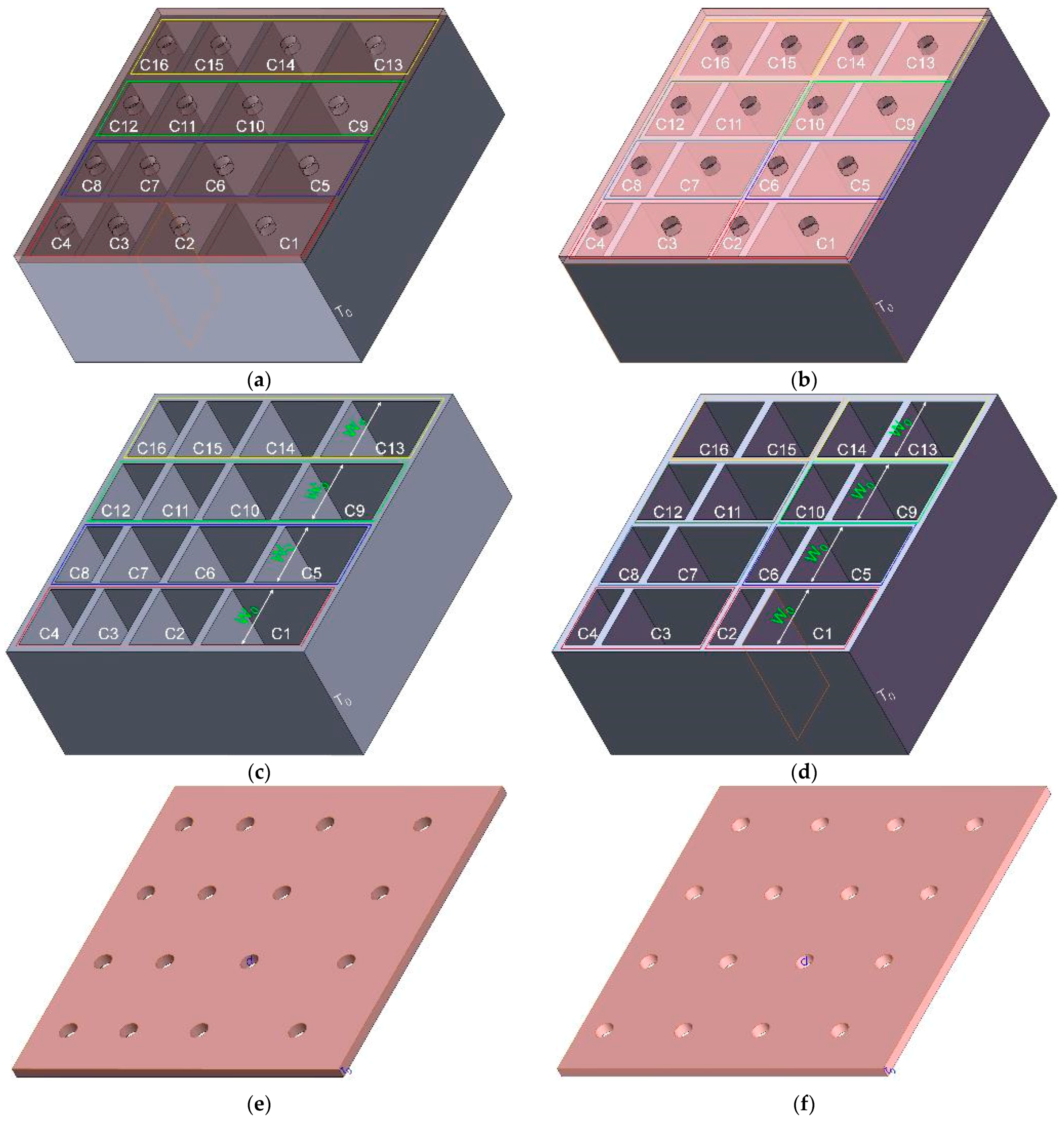

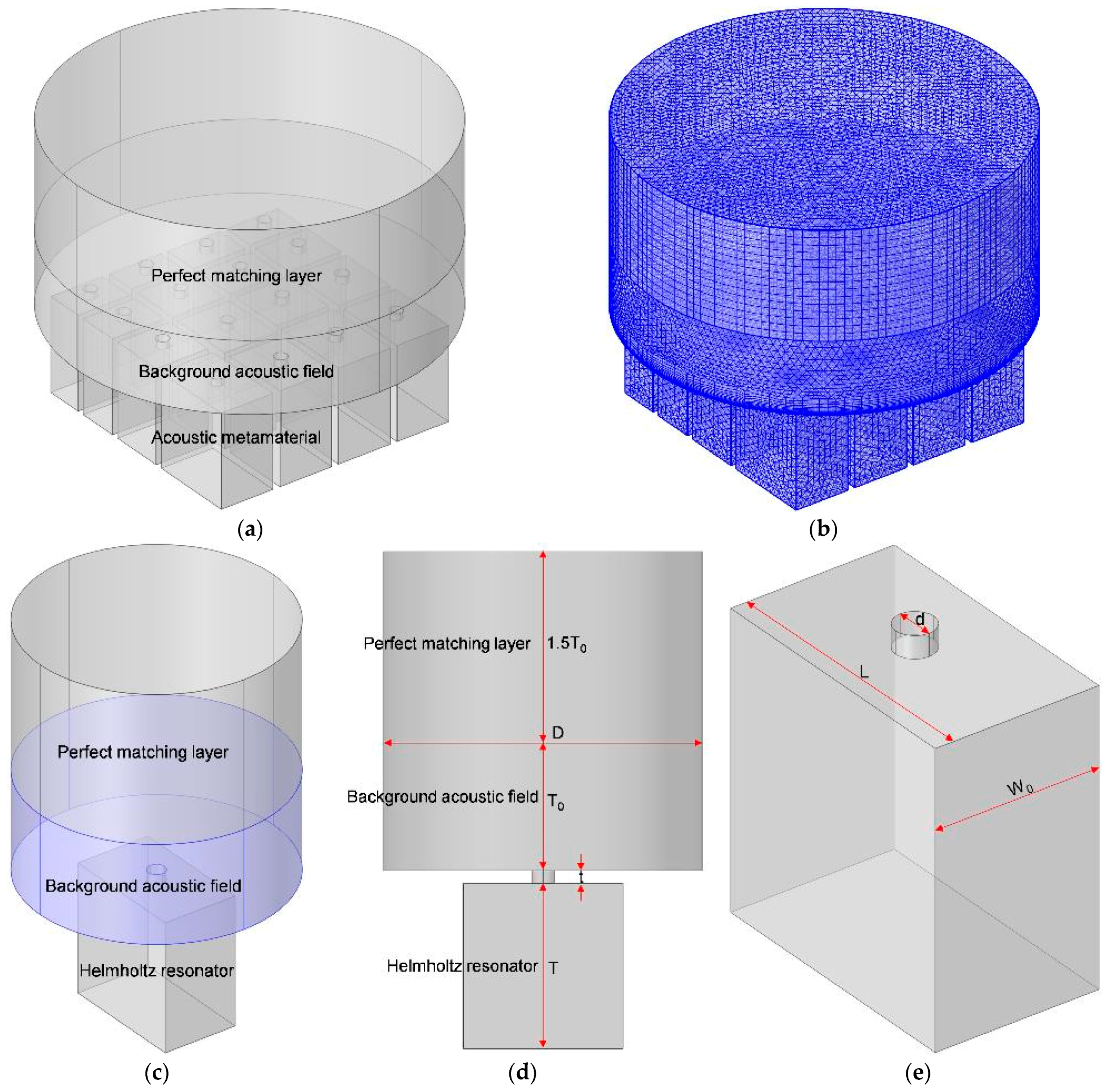

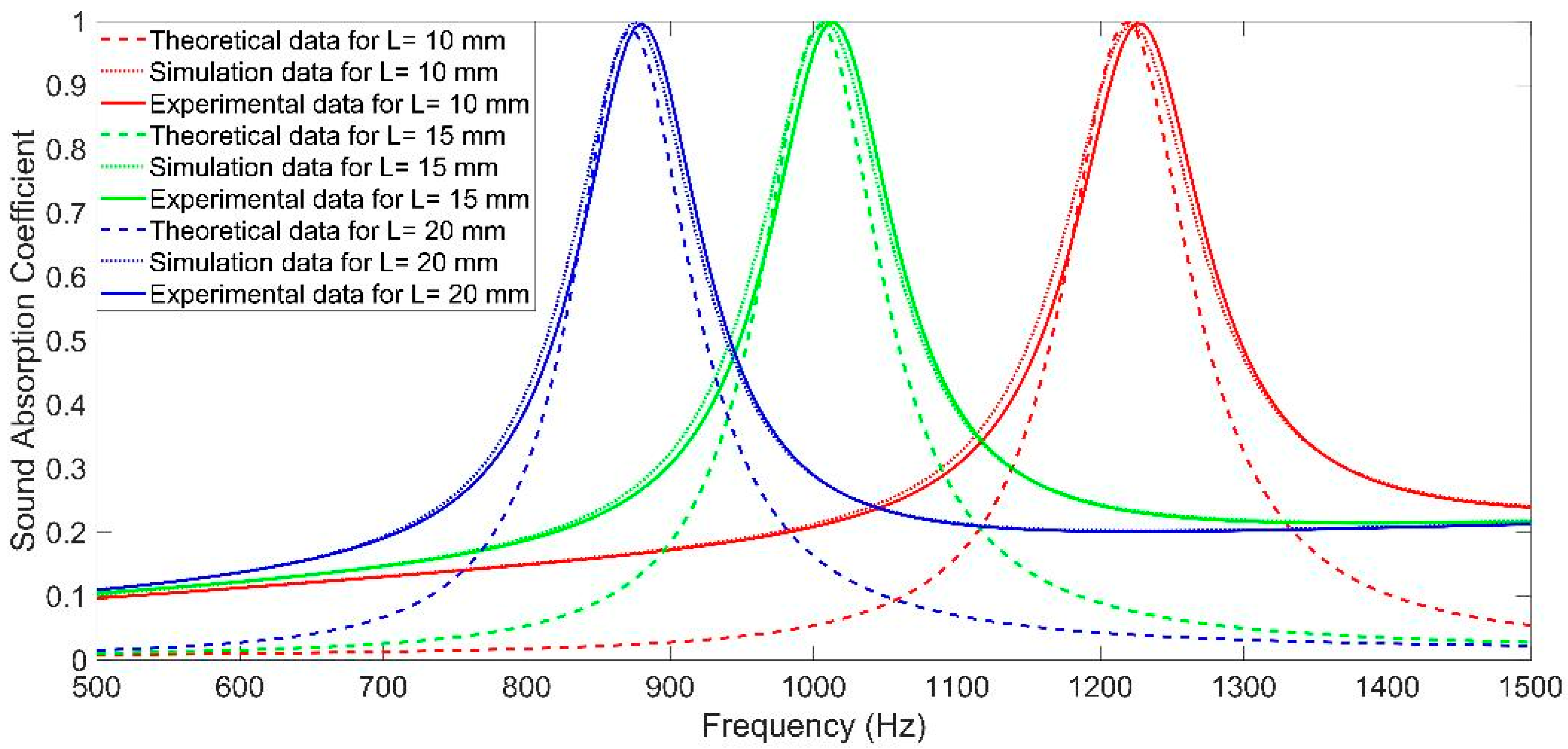


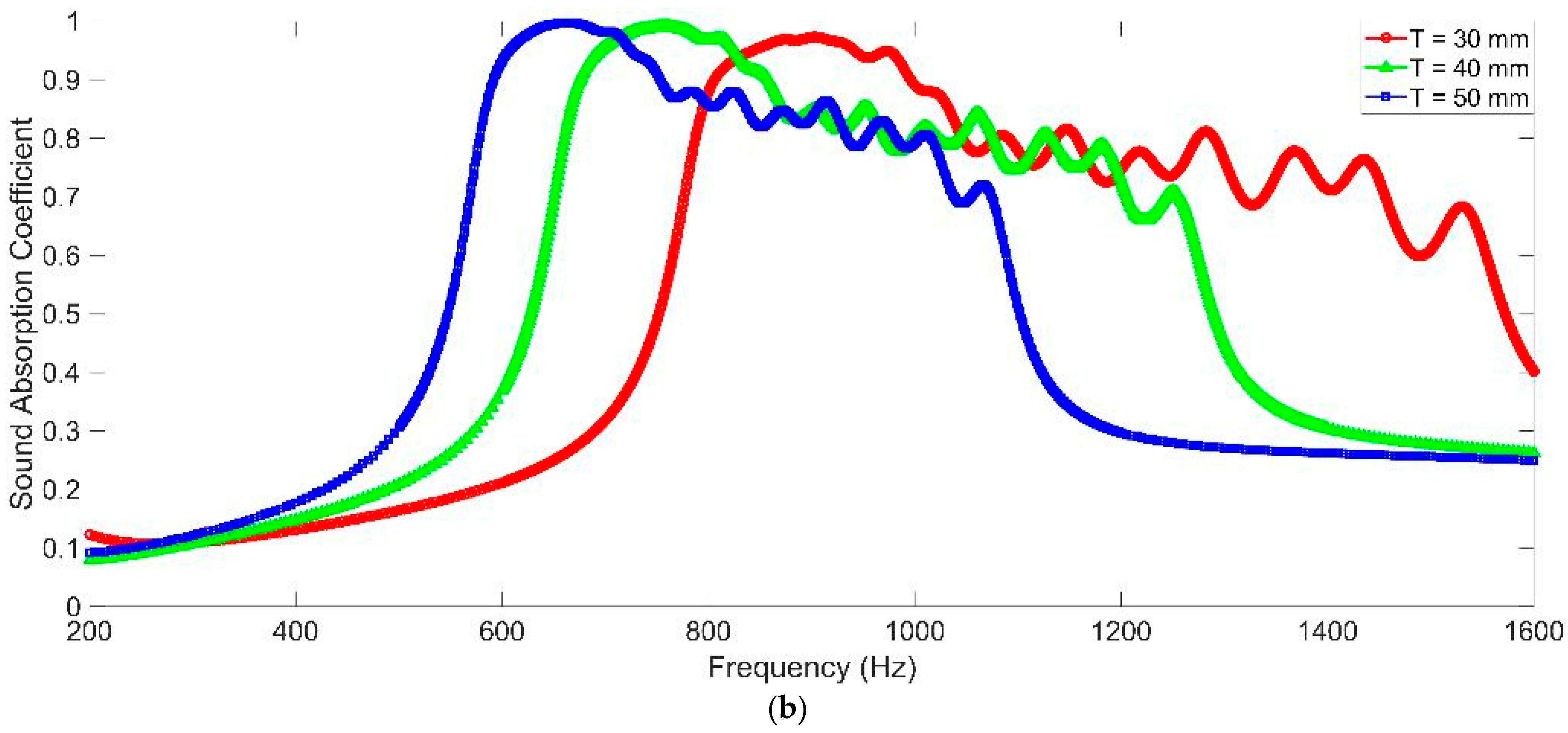
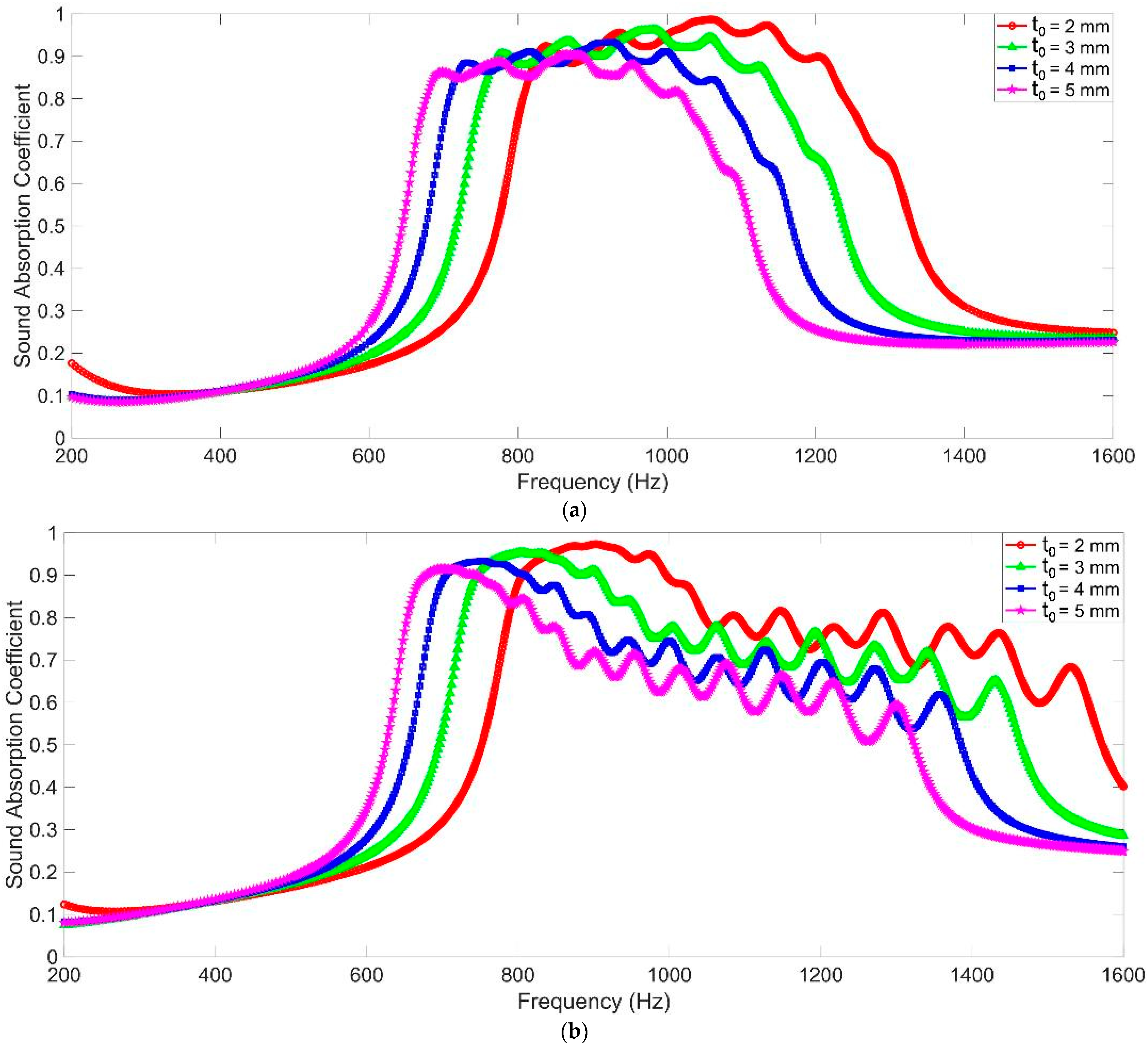
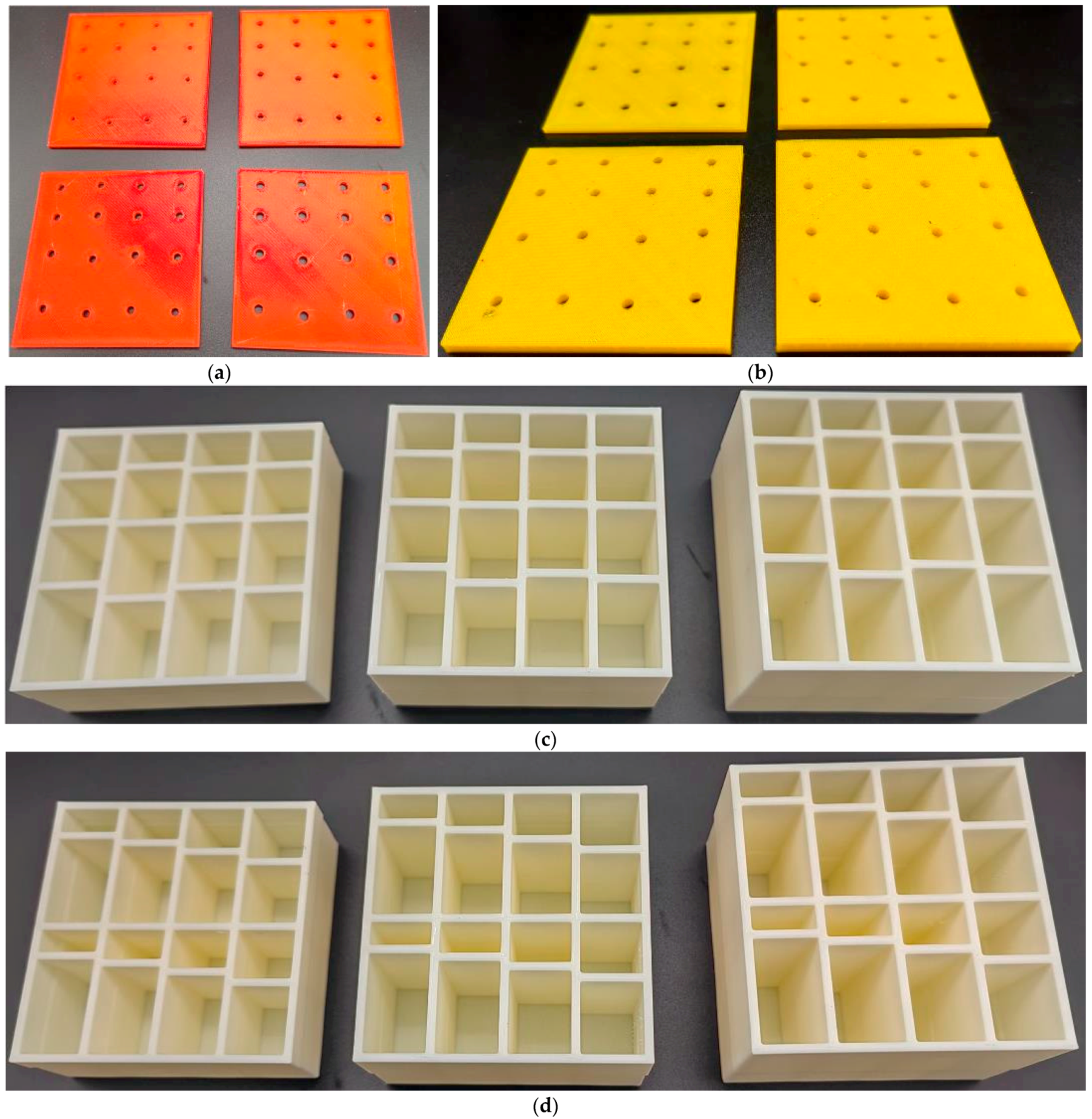


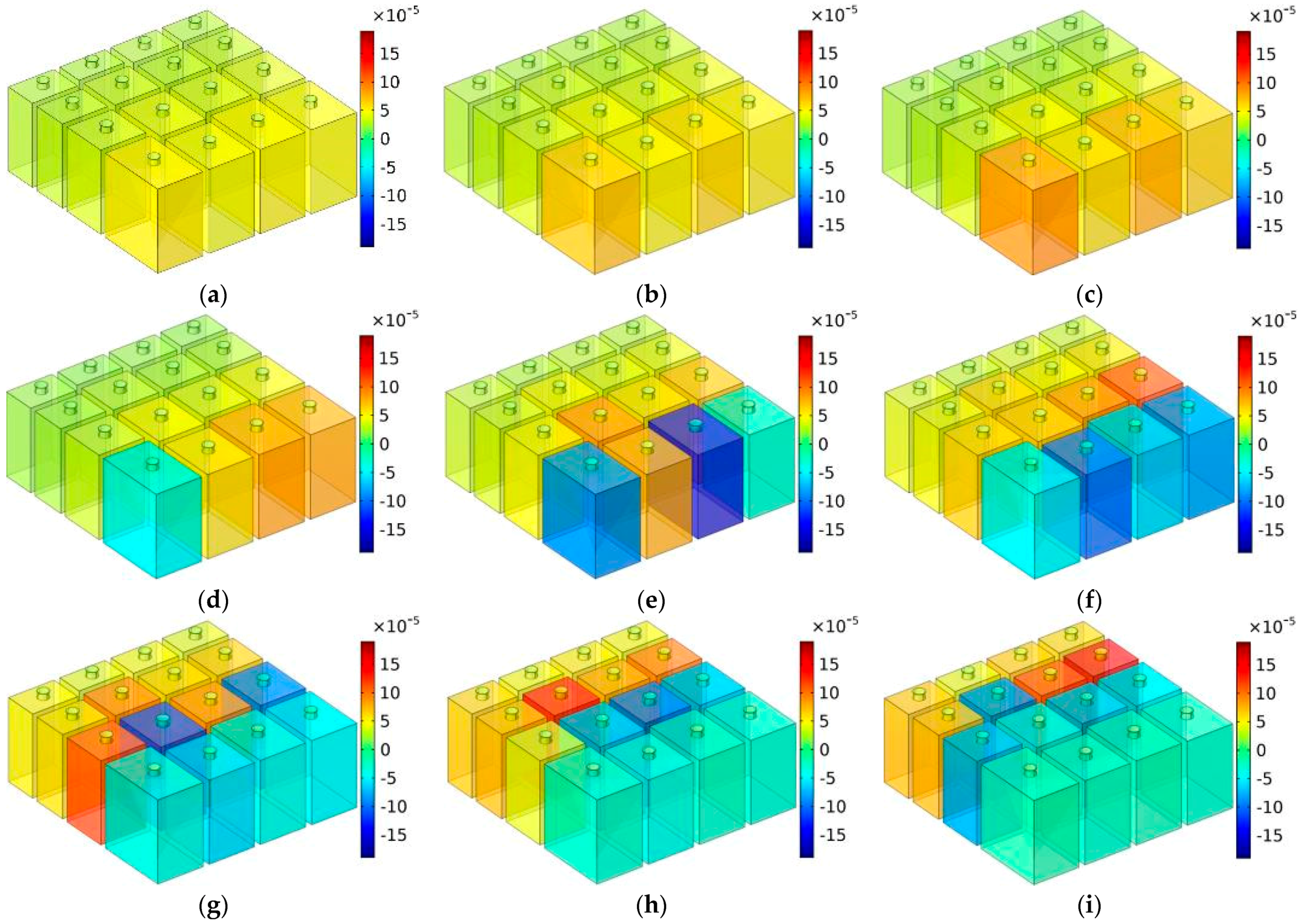
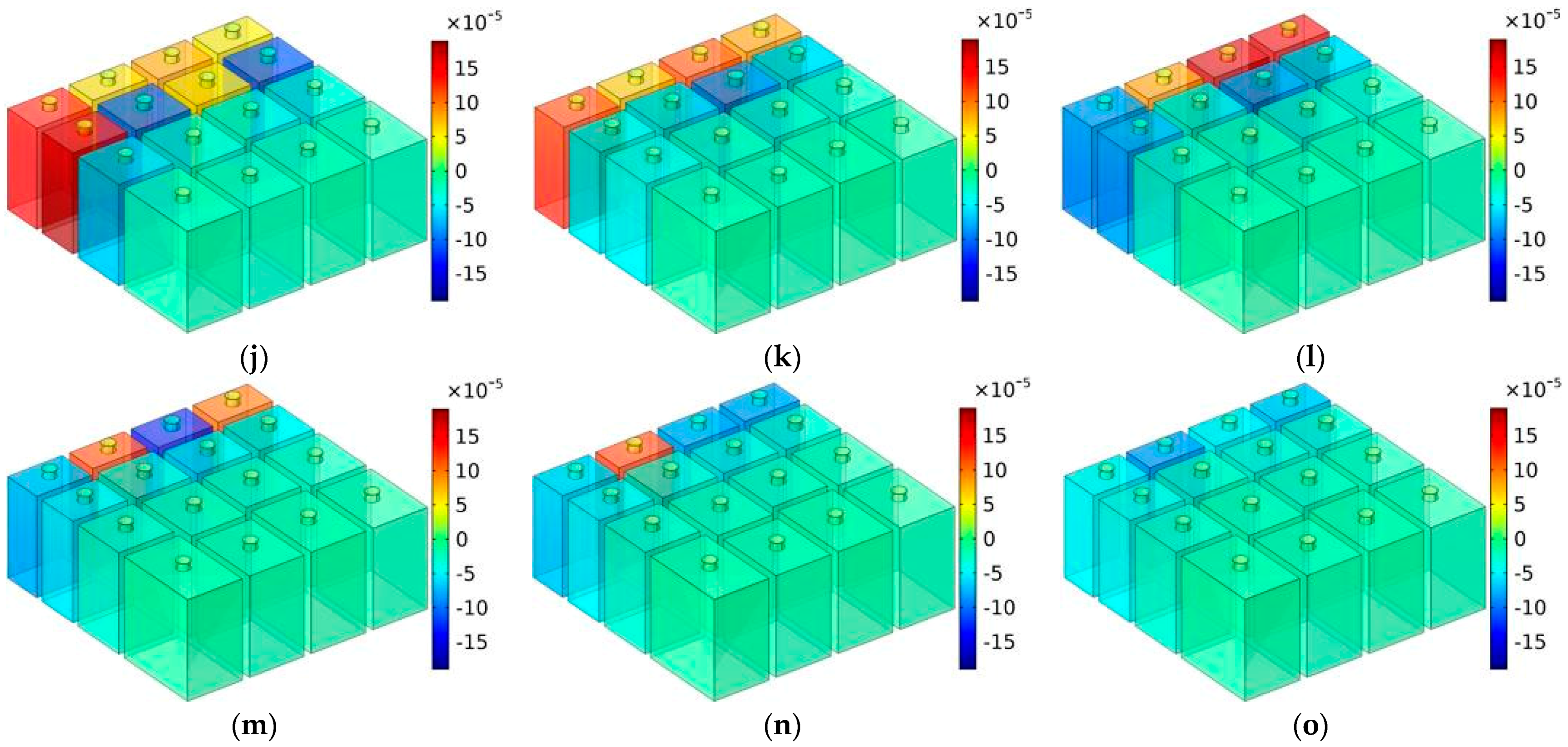

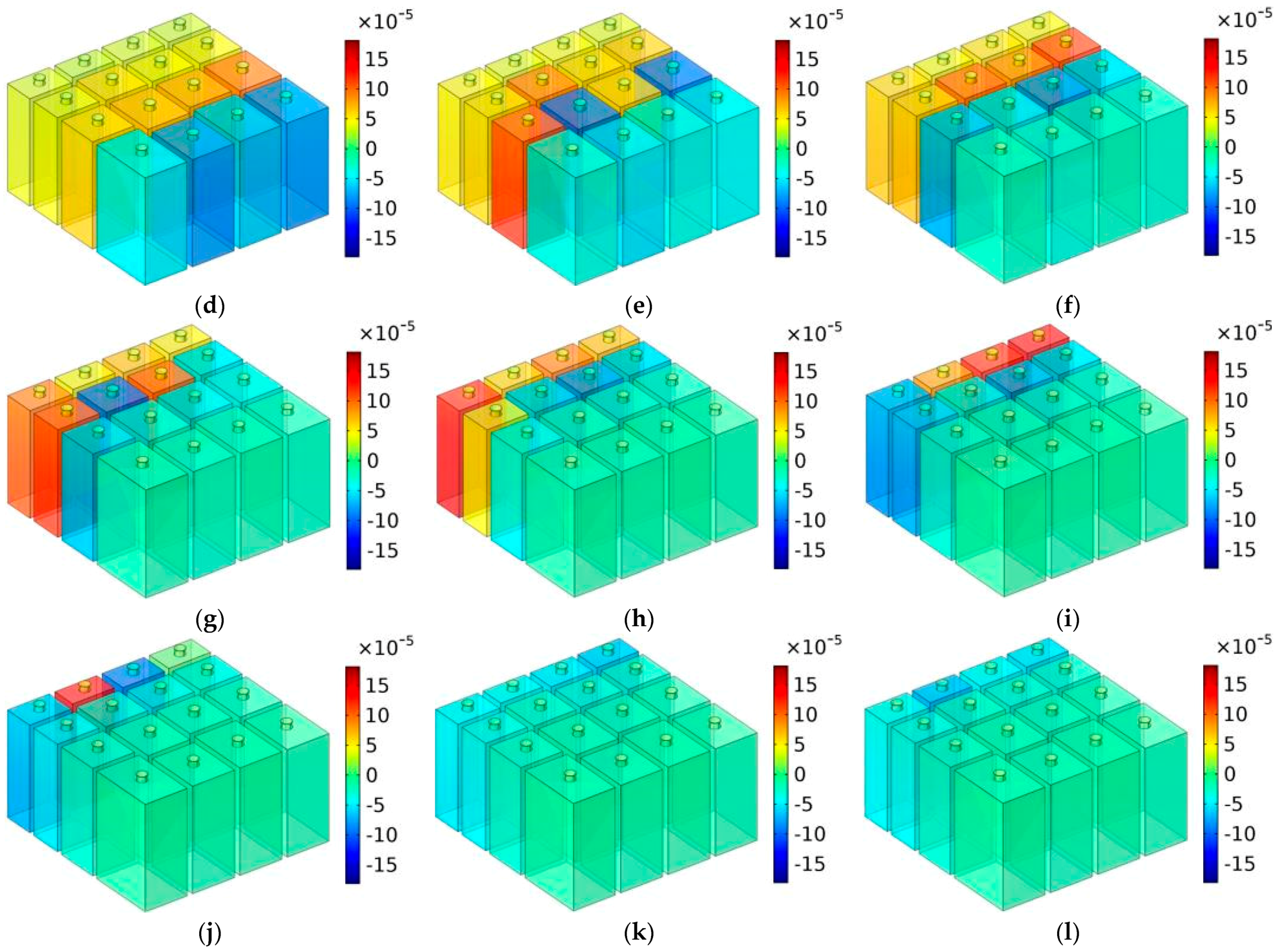


| Parameters | Value or Type | Parameters | Value or Type |
|---|---|---|---|
| The type of mesh | Extremely fine mesh | The type of acoustic field | Plane wave |
| The type of grid | Free tetrahedral grid | The amplitude of the background field | 1 Pa |
| The selected solver | Steady-state solver | The direction of the incident wave | (0, 0, −1) |
| The maximum unit size | 2 mm | The equilibrium pressure | 1 atm |
| The minimum unit size | 0.02 mm | The equilibrium temperature | 293.15 K |
| The maximal unit growth rate | 1.3 | The number of layers in the distribution | 15 |
| The curvature factor | 0.2 | The number of layers in the boundary | 8 |
| The resolution of the narrow region | 1 | The stretch factor in the boundary | 1.2 |
| The investigated frequency range | 200–1600 Hz | The regulation factor for the thickness | 1 |
| Sound Absorption Performance | The Length of Chamber L (mm) | |||||||
|---|---|---|---|---|---|---|---|---|
| 10 | 12 | 14 | 16 | 18 | 20 | 22 | 24 | |
| Resonance frequency (Hz) | 1222 | 1123 | 1044 | 1008 | 977 | 921 | 875 | 835 |
| Peak sound absorption coefficient | 0.9947 | 0.9977 | 0.9992 | 0.9998 | 0.9999 | 0.9998 | 0.9992 | 0.9984 |
| Chambers | Thickness of Panel t0 | Depth of Chamber T0 | Diameter of Aperture d | Length of Chamber Li |
|---|---|---|---|---|
| C01 | 2 mm | 30 mm | 3.5 mm | 23.2 mm |
| C02 | 2 mm | 30 mm | 3.5 mm | 14.9 mm |
| C03 | 2 mm | 30 mm | 3.5 mm | 11.3 mm |
| C04 | 2 mm | 30 mm | 3.5 mm | 10.6 mm |
| C05 | 2 mm | 30 mm | 3.5 mm | 19.3 mm |
| C06 | 2 mm | 30 mm | 3.5 mm | 18.2 mm |
| C07 | 2 mm | 30 mm | 3.5 mm | 14.0 mm |
| C08 | 2 mm | 30 mm | 3.5 mm | 8.5 mm |
| C09 | 2 mm | 30 mm | 3.5 mm | 21.9 mm |
| C10 | 2 mm | 30 mm | 3.5 mm | 16.0 mm |
| C11 | 2 mm | 30 mm | 3.5 mm | 12.2 mm |
| C12 | 2 mm | 30 mm | 3.5 mm | 9.9 mm |
| C13 | 2 mm | 30 mm | 3.5 mm | 20.6 mm |
| C14 | 2 mm | 30 mm | 3.5 mm | 17.1 mm |
| C15 | 2 mm | 30 mm | 3.5 mm | 13.1 mm |
| C16 | 2 mm | 30 mm | 3.5 mm | 9.2 mm |
| Chambers | Thickness of Panel t0 | Depth of Chamber T0 | Diameter of Aperture d | Length of Chamber Li |
|---|---|---|---|---|
| C01 | 2 mm | 30 mm | 3.5 mm | 14.2 mm |
| C02 | 2 mm | 30 mm | 3.5 mm | 15.8 mm |
| C03 | 2 mm | 30 mm | 3.5 mm | 12.7 mm |
| C04 | 2 mm | 30 mm | 3.5 mm | 17.3 mm |
| C05 | 2 mm | 30 mm | 3.5 mm | 11.3 mm |
| C06 | 2 mm | 30 mm | 3.5 mm | 18.7 mm |
| C07 | 2 mm | 30 mm | 3.5 mm | 10.0 mm |
| C08 | 2 mm | 30 mm | 3.5 mm | 20.0 mm |
| C09 | 2 mm | 30 mm | 3.5 mm | 8.8 mm |
| C10 | 2 mm | 30 mm | 3.5 mm | 21.2 mm |
| C11 | 2 mm | 30 mm | 3.5 mm | 7.7 mm |
| C12 | 2 mm | 30 mm | 3.5 mm | 22.3 mm |
| C13 | 2 mm | 30 mm | 3.5 mm | 6.7 mm |
| C14 | 2 mm | 30 mm | 3.5 mm | 23.3 mm |
| C15 | 2 mm | 30 mm | 3.5 mm | 5.8 mm |
| C16 | 2 mm | 30 mm | 3.5 mm | 24.2 mm |
Disclaimer/Publisher’s Note: The statements, opinions and data contained in all publications are solely those of the individual author(s) and contributor(s) and not of MDPI and/or the editor(s). MDPI and/or the editor(s) disclaim responsibility for any injury to people or property resulting from any ideas, methods, instructions or products referred to in the content. |
© 2023 by the authors. Licensee MDPI, Basel, Switzerland. This article is an open access article distributed under the terms and conditions of the Creative Commons Attribution (CC BY) license (https://creativecommons.org/licenses/by/4.0/).
Share and Cite
Yang, X.; Shen, X.; Hu, D.; Wang, X.; Song, H.; Zhao, R.; Zhang, C.; Shen, C.; Yang, M. An Investigation of Modular Composable Acoustic Metamaterials with Multiple Nonunique Chambers. Materials 2023, 16, 7627. https://doi.org/10.3390/ma16247627
Yang X, Shen X, Hu D, Wang X, Song H, Zhao R, Zhang C, Shen C, Yang M. An Investigation of Modular Composable Acoustic Metamaterials with Multiple Nonunique Chambers. Materials. 2023; 16(24):7627. https://doi.org/10.3390/ma16247627
Chicago/Turabian StyleYang, Xiaocui, Xinmin Shen, Daochun Hu, Xiaoyong Wang, Haichao Song, Rongxing Zhao, Chunmei Zhang, Cheng Shen, and Mengna Yang. 2023. "An Investigation of Modular Composable Acoustic Metamaterials with Multiple Nonunique Chambers" Materials 16, no. 24: 7627. https://doi.org/10.3390/ma16247627






